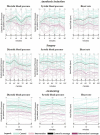Outcomes of dexmedetomidine as adjuvant drug in patients undergoing videolaparoscopic cholecystectomy: A randomized and prospective clinical trial
- PMID: 37604516
- PMCID: PMC10467245
- DOI: 10.1177/03946320231196977
Outcomes of dexmedetomidine as adjuvant drug in patients undergoing videolaparoscopic cholecystectomy: A randomized and prospective clinical trial
Abstract
Objective: The repercussions of ischemia-reperfusion and inflammatory response to surgical injury may compromise the return of physiologic processes in video-laparoscopic surgeries. Dexmedetomidine, as an adjuvant drug in general anesthesia, alters the neuroinflammatory reaction, provides better clinical outcomes in the perioperative period, and may reduce the excessive use of chronic medication in patients with a history of addiction. This study evaluated the immunomodulatory potential of dexmedetomidine on perioperative organ function in video-laparoscopic cholecystectomy patients.
Methods: There were two groups: Sevoflurane and Dexmedetomidine A (26 patients) vs. Sevoflurane and Saline 0.9% B (26 patients). Three blood samples were collected three times: 1) before surgery, 2) 4-6h after surgery, and 3) 24h postoperatively. Inflammatory and endocrine mediators were protocolized for analysis. Finally, hemodynamic outcomes, quality upon awakening, pain, postoperative nausea and vomiting, and opioid use were compared between groups.
Results: We have demonstrated a reduction of Interleukin 6 six hours after surgery in group A: 34.10 (IQR 13.88-56.15) vs. 65.79 (IQR 23.13-104.97; p = 0.0425) in group B. Systolic blood pressure, diastolic blood pressure, and mean arterial pressure was attenuated in group A in their measurement intervals (p < 0.0001). There was a lower incidence of pain and opioid consumption in the first postoperative hour favoring this group (p < 0.0001). We noticed better quality upon awakening after the intervention when comparing the values of peripheral oxygen saturation and respiratory rate.
Conclusions: Dexmedetomidine provided anti-inflammatory benefits and contributed to postoperative analgesia without the depressive side effects on the respiratory and cardiovascular systems commonly observed with opioids.
Trial registration: Immunomodulatory Effect of Dexmedetomidine as an Adjuvant Drug in Laparoscopic Cholecystectomies, NCT05489900, Registered 5 August 2022-Retrospectively registered, https://clinicaltrials.gov/ct2/show/NCT05489900?term=NCT05489900&draw=2&rank=1.
Keywords: cholecystectomy laparoscopic; dexmedetomidine; immunomodulation.
Conflict of interest statement
The author(s) declared no potential conflicts of interest with respect to the research, authorship, and/or publication of this article.
Figures




References
Publication types
MeSH terms
Substances
Associated data
LinkOut - more resources
Full Text Sources
Medical

